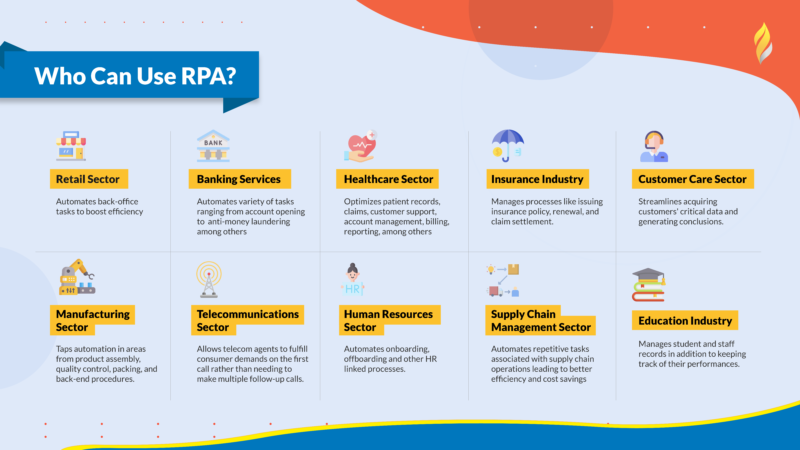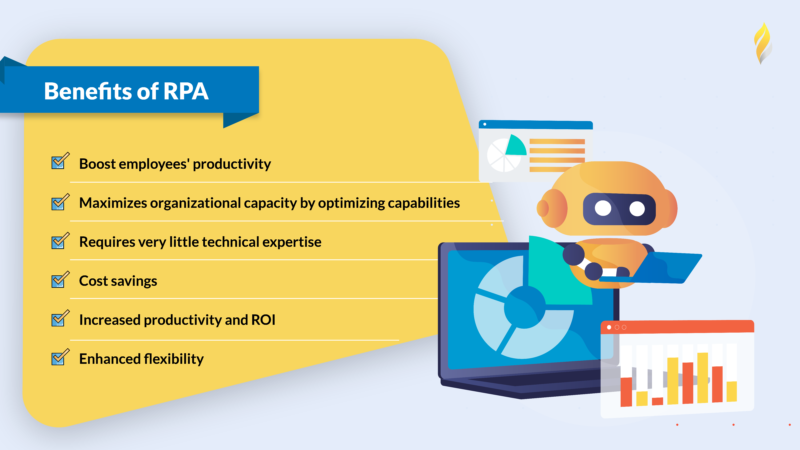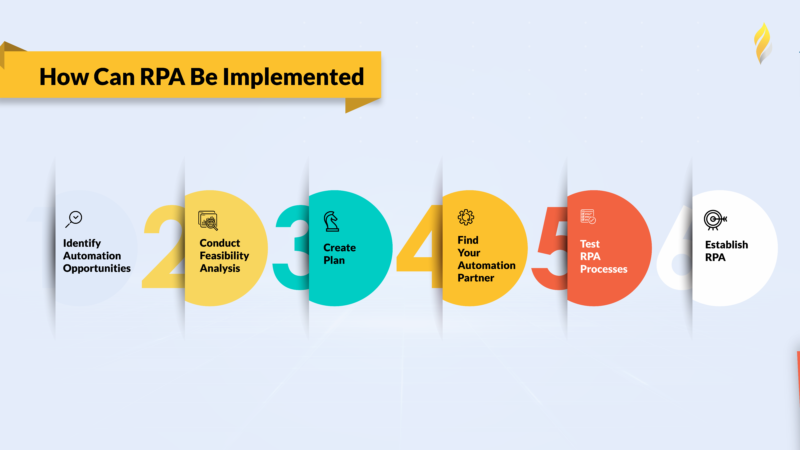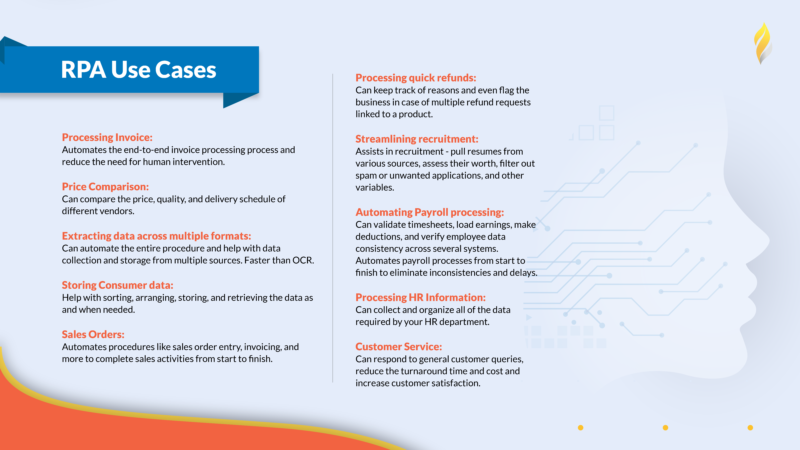Reading Time : 3 Mins
An Ultimate Guide to Robotic Process Automation (RPA)
An INFJ personality wielding brevity in speech and writing.
With the new technologies emerging, the business processes have simplified a lot. Transforming manual processes to systematic, automatic processes reduces the chances of errors and improves the results and efficiency. A crucial benefit of such a transformation is the benefit of cost. One such efficient technological advancement witnessed in the recent period is robotic process automation.
Robotic process automation is seen as the implementation of automation using machine learning and artificial intelligence that you can train to make decisions in the future. In fact, according to Research And Markets, the global robotic process automation market size is expected to grow at a GACR of 32.8% to reach USD 13.74 billion by 2028. Further, a Deloitte Global RPA Survey report suggests that 78% of those who implemented RPA are expected to increase their investment over the next three years.
RPA is delivering value and has great potential to support businesses which makes understanding the benefits and applications of RPA important. So, in this article, let us explore the details of the RPA, its benefits, and its various applications.
In this guide, you will get an overview on:
What is Robotic Process Automation (RPA)?
“RPA is an advanced form of business process automation that can record tasks performed by a human on their computer, then perform those same tasks without human intervention. Essentially, it is a virtual robot copycat.” –Marcel Shaw, Federal Systems Engineer at Ivanti.
RPA is the application of technology that mimics human interaction and assists businesses in automation. Also known as software robotics, it can perform a range of small tasks that include extracting data, filling in forms, moving files, performing calculations, transacting, triggering responses, etc. It integrates and performs repetitive operations via APIs and user interface (UI) interactions.
RPA solutions automate the execution of numerous tasks and transactions across disparate software systems by deploying scripts that mimic human processes. RPA is gaining traction due to cutting costs, streamlining processes, and improving user experiences. CIOs and other decision-makers can use RPA to speed up their digital transformation initiative for their employees and get their employees a better return on investment (ROI).
Summarizing all the points, David Landreman, CPO of Olive, quoted,
In layman’s terms, RPA is the process by which a software bot uses a combination of automation, computer vision, and machine learning to automate repetitive, high-volume tasks that are rule-based and trigger-driven.
This way, RPA can perform quite a wide range of daily life tasks to offer valuable and efficient results.
To understand RPA, let us look at an example here.
Examples Of Robotic Process Automation (RPA)
There are multiple uses of RPA. From the corporate level to daily life, multiple applications use the RPA to offer services to the customer and reduce the human load of work. Though there are multiple examples of RPA in daily life, the most common ones are given below:

RPA in Online Shopping
One of the finest examples of RPA in daily life is online shopping. Online shopping is used for buying everything from basic groceries to clothing and from jewelry to gadgets. Additionally, the number of people visiting online stores is increasing at quite a fast pace. But the important thing to know here is the back-end process of the online ordering system is managed by Robotic Process Automation (RPA).
Once the order is placed, the RPA system will analyze the variables to send it to the existing repository. It is done to properly maintain the stock and verify the order’s dispatch to the customer. Though human resources can handle these tasks, when handled by the RPA, the chances of errors are reduced. Using the RPA solutions, one can get a response quickly and efficiently.
RPA in Credit Card Functionalities
Considering financial tools like credit cards, you should respond to multiple functions. Right from filing the credit card application, collecting all the required documents, checking the credentials, completing verification, generating statements, sending reports or messages, reconciliation, and even fraud detection. All these tasks, when handled manually, are not only cumbersome but also increase complications.
Using RPA-based software to handle such processes can help a great deal. Based on the data offered by the customer, the system can analyze the eligibility for the card and help the customer find the solution to the query. Also, when the customer is eligible for the card, only the card will be delivered to his address, reducing the chances of delays and returns.
Working Process Of RPA
- Build automation scripts with low-code capabilities.
- Integration of business applications
- Configuration, monitoring, and security are part of the management process.
You can integrate RPA with the front-end applications as well. While RPA works very efficiently with the back-end integration, using the RPA for the front-end integration reveals the true value of the same.
Indeed, Antony Edwards, COO at Eggplant, rightly said,
Put simply, the role of RPA is to automate repetitive tasks that humans previously handled. The software is programmed to do repetitive tasks across applications and systems. The software is taught a workflow with multiple steps and applications.
Where can RPA be used?
RPA has applications in various industries and segments. Aimed toward streamlining daily operations and tasks, the major industries where you can notice the use of RPA are as follows:

1] Retail Sector
With the growth of the e-commerce economy, there has been a major shift in the retail industry. The majority of the consumers prefer to buy online rather than visit the stores or shops around them. One of the reasons behind this choice is better pricing and a swift delivery model. Accomplishing the back-office tasks smoothly and efficiently, RPA offers assistance for customer relationship management, warehouse and order management, customer feedback processing, and fraud detection.
2] Banking Services
Banking is one of the most important services that involve a large variety of sub-segments and services. From opening a bank account to solving customer queries, multiple operations are handled at a bank. With the help of the RPA automation solutions, various major banks have opted for automating multiple tasks, including customer research, account opening, inquiry processing, and keeping track of anti-money laundering. Handling a high volume of repetitive and tedious tasks with the help of a rule-based process helps streamline activities efficiently.
3] Healthcare Sector
Healthcare is a sector that is based on accuracy and compliance. Various multi-specialty hospitals use the RPA to streamline their processes and functions. This software is designed to optimize patient records, claims, customer support, account management, billing, reporting, and analytics which are crucial.
4] Insurance Industry
When it comes to the insurance industry, most processes like issuing an insurance policy, renewal, and claim settlement are repetitive. These tasks are time-consuming and lengthy when humans process, leading to errors. The RPA automation software can efficiently manage all the processes linked to claims processing operations, regulatory compliance, policy management, and underwriting tasks.
5] Customer Care Sector
Customer care is an industry that offers service to every segment. The call centers and BPOs are the ones that are benefited from the RPA at quite a high rate. Robotic process automation is a viable option for BPOs regarding rule-based redundant labor. Executives in customer service work in a data-driven environment. Customers’ critical data is acquired, and conclusions are generated. RPA streamlines the entire process, saving time and money while providing better and faster service to clients. Outsourcers and clients will benefit from this as well.
6] Manufacturing Sector
The manufacturing industry uses machines to produce and pack the products to reach the final consumers. The process is based on a predefined set of rules and procedures fed into the computer. Hence, many manufacturing organizations have shifted their production units to automated software bots due to robotic process automation. Automation has resulted in significant cost savings in product assembly, quality control, packing, and back-end procedures.
7] Telecommunications Sector
Another sector that uses the RPA is telecommunications. Speed, affordability, and technology are the three most important criteria for a telecommunications provider. The ability to automate back-office procedures frees up personnel to focus on more important activities by removing the need for them to do redundant tasks. RPA allows software bots to quickly access data, allowing telecom agents to fulfill consumer demands on the first call rather than needing to make multiple follow-up calls.
8] Human Resources Sector
The human resource department of any organization is entrusted with managing the staff and their linked processes. A robust human resource department assures timely onboarding, management, and a satisfactory workforce. Managing the data linked to staff manually is quite lengthy and time-consuming. It can lead to errors which can cause dissatisfaction among the employees. HR functions such as onboarding and offboarding, updating employee information, managing their contact details, creating contracts, and timesheet submission can be automated with RPA.
9] Supply Chain Management Sector
For any business or industry to operate effectively without any lapses, it is important to have a steady supply of resources. This is where the supply chain management service comes in. RPA can help automate the operations linked to procurement, delivery, ordering, payment, inventory management, shipment tracking, returns management, and filing reports. This can improve efficiency and help the business earn better profits.
10] Education Industry
Last but not least, the education industry can use RPA and get multiple benefits from the same. RPA can be used to manage the student and staff records and keep track of performances. Additionally, the exemplary implementation of RPA can also help keep track of student fee payments, payroll, data linked to exams, and even new enrollments and recruitments, which is very helpful.
What are the Benefits of RPA
Organizations are becoming interested in robotic process automation (RPA). It increases the earnings, but it also increases the productivity of the personnel. RPA can also improve the efficiency of the firm.
The main benefits of the RPA are as follows:
1] Scales up productivity
The primary purpose of implementing the RPA tool is to optimize routine tasks. Automating mundane and repetitive human tasks with the help of the robotic, automatic process can improve employees’ productivity. Employees can focus more on client and customer engagement, relationship management, and other areas where people naturally excel since RPA frees them from monotonous chores. Clients and customers who are happy mean more business for you.
2] Error-free compliance
Every business process needs to have compliance. When performed by humans, the chances of accuracy and quality in repetitive tasks are comparatively low. This might cause issues with the performance and results. On the other hand, RPA can operate 24/7 without any hassle. According to the Deloitte Global RPA Survey, RPA met or exceeded 85% of respondents’ accuracy, timeliness, and flexibility expectations. RPAs are dependable, steady, and capable of working indefinitely. As a result, RPA maximizes organizational capacity by optimizing capabilities.
3] Requires less coding
The user doesn’t need to be a coder of a high level to use the RPA. If the user is aware of the drag-and-drop features in user interfaces, then the developer can easily onboard the non-technical staff for the RPA operations. So, when the business expands and moves to new segments using the RPA in those is an easy task.
4] Drives ROI
Humans can only devote a certain number of hours every day; their efficiency is limited. RPA software, on the other hand, can work endlessly without requiring any rest or break. It doesn’t require sick days or vacations. It is available 24*7 for 365 days a year. One RPA robot can execute as much work as two to five full-time employees can manually. Because RPA decreases team workload, you can move workers to other high-value tasks that require human involvement, resulting in increased productivity and ROI.
5] Saves on expenses
The majority of the businesses are concerned about the costs. The lower the costs, the higher would be the profit generated. Employing staff for repetitive tasks increases the recurring costs, whereas using the RPA, you can slash these costs down to a respectable amount. As per a report from EY, RPA can save from 20% to 60% of the cost of a full-time employee for financial services. Having RPA take over some of the labor-intensive tasks that humans do could benefit the company. Automation can help you recover the investment in a short period, and then it’s all about profits.

6] Improves customer experiences
The biggest challenge for businesses is to meet the customer’s demands and offer them smooth services. Delay in offering customer service or attending to their queries can lead to negative publicity. Using the RPA can resolve this issue. Customer and client happiness rises due to higher work quality, accuracy, and improved customer/client contact. When mundane, repetitive jobs are delegated to bots, staff will have more time to respond to client inquiries. They can cut consumer wait times. This just adds to the company’s goodwill.
7] Harness intelligent automation
AI is data-driven, whereas RPA is process-driven. AI bots use machine learning to discover patterns or sets in data, particularly unstructured data, and learn over time. In contrast, RPA bots can only follow the processes set by an end-user. RPA and AI, on the other hand, work well together. RPA can benefit from AI to help it automate processes more completely and handle more complicated use cases. RPA also allows AI insights to be implemented faster than waiting for manual implementations. This has the potential to increase the scale of performance and usefulness.
8] Supports employee morale
The most important resource for any business is human resources. When the employees are dissatisfied, or their morale is low, the chances of gaining a high level of benefits and productivity are low. Humans are prone to errors when working for an extended period or are performing repetitive and arduous tasks. To achieve great efficiency in company operations, you must eliminate the danger of errors. You can easily automate routine business procedures with RPA. Employees are freed from tedious and repetitive jobs. This allows them to concentrate on strategic activities worthy of their time and effort, leading to growth and prosperity. Employee happiness is improved as a result of this shift in employment.
9] Expands flexibility
Businesses prefer to have flexibility in their operations. When making simple changes to the existing process, the business can easily earn economies of scale. The business can ensure better flexibility by allowing the staff to focus on more strategic and critical operations while the RPA handles the repetitive and mundane tasks. Since RPA can support many functions to help achieve the business objective and even manage unpredictable situations, the flexibility is enhanced.
10] Doesn’t disrupt the existing system
RPA is designed in such a manner that it supports the existing business process without causing any disruption or hurdle. It can work with the existing modules and can support the staff. At the same time, many employees fear that the implementation of RPA can be a loss for them, but this is not true. A study commissioned by UiPath and conducted by Forrester Consulting suggests that around 57% of the employees are happy with RPA and confirms an increment in the engagement rate. No disruption in the existing system improves employee morale and increases productivity.
11] High level of security
Robotic process automation (RPA) bots are programmed to complete specified tasks. There’s little possibility of data leaking from one side to another because Robotic Process Automation works at such a granular level. All data accesses are documented and controlled to the fullest extent possible. RPA implementation also demands a workforce capable of managing (and controlling) both humans and machines. It creates more jobs than it destroys, as with any new technology.
12] Better analytics
Improved analytics is one of the most tangible commercial benefits of robotic process automation. RPA can help businesses collect vital data so they can make better decisions. Examples include cycle times, work volume patterns, errors, and exceptions. You can improve your product/service for the target market with better analytics. RPA enables you to streamline your business processes for maximum efficiency further.
Difference Between RPA And Intelligent Automation
One of the major questions is the difference between the RPA and the Intelligent AUtomation. Employees can focus on more creative and inventive work with the support of intelligent process automation and robotic process automation. This reflects that the basic purpose of both is the same. IA is usually mistaken for RPA, but that’s not true. You can implement RPA on IA platforms, but it is not required for RPA to work.
RPA refers to technology tools and methods that automate and speed up the completion of time-consuming jobs. These are usually rule-based, recurring, and straightforward tasks. Because the systems are programmed to obey a precise set of rules, RPA can be challenging at times.
This is where intelligent automation comes in. When RPA isn’t enough, IA is added, allowing the system to complete complicated procedures with AI reasoning and decision-making methodologies. IA uses artificial intelligence technology to replicate human intelligence, giving the tools and techniques needed to execute complex tasks that require thinking, judgment, decision-making, and analysis.
In other words, IA is the advanced form of RPA. It combines a multitude of technologies like Robotic Process Automation (RPA), Machine Learning (ML), Natural Language Generation (NLG), Natural Language Processing (NLP), Structured Data Interaction (SDI), AI-Decision systems, Chatbots, and more.
Although RPA and IA are both the most advanced technologies that help streamline the processes and automate the functions. IA is more beneficial for more complex and integrated tasks with an innovative process that improves efficiency and optimizes resources. When a task is based on a set of rules and is repetitive, RPA is the right choice to move ahead with. Indeed, these two technologies might be different but are the driving forces helping businesses reach the pinnacle of success.
We’ve covered more differences between RPA and Intelligent Automation in this blog here.
How Can RPA Be Implemented
One of the best options to implement on your digital transformation path is robotic process automation (RPA). It is important to ensure that every step is followed judiciously to implement the RPA. The main steps included in the implementation of the RPA are as follows:

1] Make a list of processes to automate
The first thing to do is to make a list of all the processes to be automated. The selection of the processes should be based on a proper strategy and prioritizing the activities that will help achieve better ROI and are complex. Remember that not all the processes are appropriate for RPA.
2] Feasibility analysis
The next step is to perform the feasibility analysis. The in-depth analysis of the RPA implementation in terms of cost and result expected is important. Proper examination and technical analysis will ensure that the business earns economies of scale by implementing the RPA.
3] Draft the plan
Once the feasibility analysis is done, it is time to draft the plan. Based on the outcome of the analysis, the process to be automated needs to be sorted down. The processes that are not properly optimized or structured need to be restructured before moving ahead with the RPA implementation.
4] Move ahead with the development process
Once the plan is drafted, the next step is to move ahead with the development process. Connect with an RPA expert who can guide you on the right way to design the tool or software to be implemented. Since each RPA has different capabilities and functionalities, working on a properly defined RPA workflow is crucial.
5] Test the RPA process
Conduct extensive testing to examine performance in all possible scenarios and identify faults when the procedure is run. Send any potential performance or bug issues to the development team for resolution.
6] Confirm and establish RPA
Once the initial testing is done and the modifications are made, ensure to test again. Once confirmed with the testing, move ahead with the deployment of the RPA solution. Ensuring a smooth deployment is essential to ensure efficient performance in the long run.
Challenges of RPA
Though the benefits and applications of RPA are quite enormous, one cannot deny the fact that there are some inclusive challenges as well. Organizations frequently underestimate the time and expense of implementing RPA. According to a Deloitte Global RPA Survey, 63% of respondents stated their expectations for time to adopt were not fulfilled, and 37% said it did not meet their expectations for the cost to implement. Likewise, there are multiple challenges faced by the RPA, which are as follows:
1] Organizational culture
Organizational culture consists of the working process, rules, and workforce. One of the biggest challenges linked to the implementation of the RPA is the resistance based on the organizational culture. Lack of a culture of learning and innovation will create fear regarding the RPA among the existing staff, which is a big challenge for the smooth application.
2] Scalability
Scalability is one of the biggest challenges faced during RPA implementation. Though the RPA solutions are simple to install, the management can be tough at times. The lack of proper resources and staff to manage the RPA operations is a challenge in scalability.
3] Focused on short term goals
Most of the RPA solutions are designed to meet short-term goals and results. But when a business is looking for a long-term solution, then RPA can be a challenge. It necessitates multi-channel platforms with complicated workflows that must be reviewed and optimized regularly.
RPA success story of a F500 company
World’s largest F500 company magnifies speed and quality of its HR functions using RPAClick below to read the full story
4] Capability issue
RPA tools and solutions are indeed highly advanced and well-established. But when it comes to complex processes, RPA offers limited capability. Using the AI and other technical options with RPA will reach an advanced form of RPA known as AI, which is a bit more advanced. The capability issue is there when there is a lack of skilled resources to handle the RPA.
5] Security and privacy challenges
RPA may use bots to work with personally identifiable information subject to privacy regulations. Teams must guarantee that this information is handled following local data protection legislation. RPA bots may need to access sensitive data to fulfill their tasks. Firms face an additional security risk if they are compromised.
6] Wrong use case for automation
A major challenge that hinders RPA adoption and lowers ROI is identifying the wrong use cases for automation. Incorrect selection of use cases will not make the proper implementation of RPA hard but will also cause unwanted costs. That’s why it’s critical to build a case for a proof of concept before moving forward with automation.
RPA Use Cases
RPA allows businesses to automate repetitive tasks that are performed regularly. Saving time and cost, RPA offers the facility to the staff to work on better and strategic projects and learn new skills needed in the competitive environment. The main use cases of the RPA that define its application and high level of utility for the organizations are as follows:
1] Processing Invoice
Businesses usually have many invoices that need to be processed on time to ensure a proper payment cycle. Being a repetitive manual task, the chances of errors are quite high. Delay in payment can hamper the delivery of goods and services and impact the business image. Using RPA can reduce the burden of paper-based invoice processing. It can gather the data, analyze, separate it easily and offer valuable information to the business. RPA can automate the end-to-end invoice processing process and reduce the need for human intervention.
2] Price Comparison
Bulk purchasing is a part of the business. The cost of the purchased items impacts the manufacturing cost and profits. While businesses do perform research, it is time-consuming and lengthy. But using RPA solutions to compare the price, quality, and delivery schedule of different vendors, businesses can get the best resources at the most affordable price.
3] Extracting data across multiple formats
Data is available in multiple formats. Professionals that work in data entry have difficulty reading the data and entering it into the system. Although optical character recognition technology is available to help, the process is still time-consuming. RPA can automate the entire procedure and help with data collection and storage from multiple sources. Employees spend 10% to 20% of their time on recitative computer chores like this. RPA can help you save time and put it to better use.
4] Storing Consumer data
The consumer data associated with any industry is quite high. RPA can help with sorting, arranging, storing, and retrieving the data as and when needed. The consumer data can be retrieved by the representatives when needed, and this can be useful in offering services to the customers. Since RPA is more accurate than humans, the solutions are more accurate.
5] Sales Orders
Having the order summary in a proper format is important for online platforms. Additionally, sales representatives need access to the sales records to offer assistance to the customers. All this work is quite extensive and time-consuming. RPA can automate procedures like sales order entry, invoicing, and more to complete sales activities from start to finish. It will assist with the maintenance of a database by deleting duplicate data, improving client experience, and increasing the pleasure of your sales workers by eliminating all time-consuming chores.

6] Processing quick refunds
The name of the business depends on the quality of service it offers. One such service includes refund processing. In case of any order return, the refund needs to be processed post-checking all the credentials of the returned order. Usually, return orders are associated with complaints that generate quite a high amount of data. The RPA system can deal with all such data with ease and efficiency. It can keep track of reasons and even flag the business in case of multiple refund requests linked to a product. This way, businesses can gain a positive reputation as well.
7] Streamlining recruitment
There is no doubt that the recruitment process is lengthy and passive. From inviting resumes to sorting them and then interviewing the candidates and spotting the best ones to make an offer, the process involves many resources and time. Robotic Process Automation can also assist in recruitment, greatly speeding up the process. The system may pull resumes from various sources, assess their worth, filter out spam or unwanted applications, and other variables. This can significantly speed up the hiring process.
8] Automating Payroll processing
Payroll processing is indeed a monthly repetitive task. The HR team handles this, but managing payroll manually can create errors and problems when the workforce is sizable. This can also lead to delays in processing salary to the staff, creating a force of dissatisfied staff. RPA can validate timesheets, load earnings, make deductions, and verify employee data consistency across several systems. It can also automate the generation of paychecks, benefits, and reimbursements. RPA may automate payroll processes from start to finish to eliminate inconsistencies and delays.
9] Processing HR Information
Human resources are one of the most prominent departments of any business. Processing HR information can sometimes be a tedious and lengthy task that can take enormous time. The RPA system can collect and organize all of the data required by your HR department. RPA can filter and store data such as personnel history, payroll, reimbursements, and degree of training. It can handle all day-to-day responsibilities, freeing up your HR staff to focus on the human side of things.
10] Customer Service
RPA is highly used in the customer service segment. Using the RPA bots to respond to general customer queries can help the business. It can reduce the turnaround time and cost and increase customer satisfaction. Additionally, when customers can get their generic queries resolved with the help of a bot, the waiting period in a queue is reduced. This also allows the customer service staff to handle specific and more crucial queries, thereby increasing customer satisfaction.
How To Calculate The ROI of RPA Investment?
When RPA is implemented correctly, it can deliver a high ROI. Before calculating the ROI of RPA investment, it is important to understand that there is more than one way of looking at the RPA benefits. Starting from financial benefits to various intangible benefits that include employee motivation or the opportunity cost of errors avoided using RPA.
There is a straightforward ROI formula. It’s just that applying it to RPA is tricky. You compute ROI by subtracting the initial investment value from the final investment value. This is referred to as the net return. The net return is then divided by the investment cost multiplied by 100. To apply this formula to calculate the ROI on RPA investment, here are the things to calculate first:
1] Automation Cost (AC)
There are four metrics involved in the cost of the RPA. It includes the cost of the RPA solution, the cost of the added infrastructure, the cost of the development of the solution, and the cost of the ongoing maintenance.
2] Employee Cost (EC)
The next metric to be calculated is employee cost. You saved the equivalent of one full-time employee’s (FTE) time for a year by automating a business procedure. The “fully loaded” yearly cost of an FTE is used to compute the dollar value of the return. Benefits, taxes, retirement plans, and other fees are all fully loaded in the term.
3] Value of Error Reduction
By filtering out operational faults, the RPA bot aids in the efficient operation of a firm. This change can be easily identified using RPA’s excellent analytics capabilities.
4] Value of process acceleration
It is the time taken to complete the set of tasks by RPA. This is the time reduced after being RPA implemented compared to the manual process.
5] Value of Time Gain (VTG)
Aside from immediate time and labor cost benefits, it is a significant component. A simple formula is used to calculate it.
Once these basic aspects are calculated, the business can move ahead with the calculator of the ROI by using the following formula:
RPA ROI Calculator = [(VTG*AC + Value of process acceleration + Value of error reduction) – AC]/AC x 100%
Where,
VTG = (EC – AC)/AC x 100%
AC = Costs of the processes performed by bots
EC = Costs of the processes performed by employees
Wrapping Up
Automation is one of the most important aspects that every business needs to focus on. But before embarking on a journey to implement the RPA for the business, it is crucial to have an in-depth understanding of the same. Analyzing various aspects and knowing the potential benefits and challenges is the key to ensuring the successful implementation of RPA.
Moving toward increased automation should begin with simple, measurable projects. Later on, you can subsequently scale and optimize for other processes and areas of your company. Look for departments and functions that need automation and can benefit from the automation. When it comes to RPA for your business, think about human resources, finance and accounting, sales, order management, payroll management, customer support, and supply chain management.
It is advisable to connect with an expert who can brainstorm with the business leaders and identify the potential areas for implementing the RPA solutions. Being a holistic approach, RPA solutions are one with great potential in the coming future.
Looking to improve your test automation coverage? Take a look at Zuci’s automated testing services and see how you can leverage Zuci for your business needs.
Related Posts

























